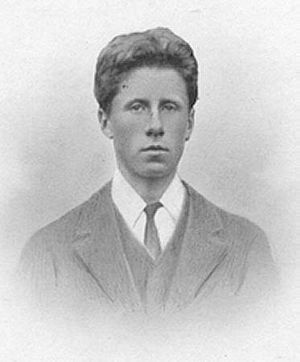Hugh Lofting facts for kids
Quick facts for kids
Hugh Lofting
|
|
|---|---|

Lofting as a young man
|
|
| Born | Hugh John Lofting 14 January 1886 Maidenhead, Berkshire, England |
| Died | 26 September 1947 (aged 61) Topanga, California, U.S. |
| Occupation | Novelist, Poet |
| Genre | Children's literature, Fantasy |
| Notable works | Doctor Dolittle |
| Notable awards | Newbery Medal 1923 |
| Relatives | Hilary Lofting (brother) |
| Military career | |
Hugh John Lofting (born January 14, 1886 – died September 26, 1947) was an English author. He trained as a civil engineer. He is famous for creating the beloved character, Doctor Dolittle. This character first appeared in special illustrated letters. Lofting wrote these letters to his children from the First World War trenches.
Contents
Hugh Lofting's Early Life
Hugh Lofting was born in January 1886 in Maidenhead, England. His parents were Elizabeth Agnes and John Brien Lofting. His family had both English and Irish roots. His older brother, Hilary Lofting, later became a novelist in Australia.
Hugh went to school at Mount St Mary's College in England. From 1905 to 1906, he studied civil engineering at the Massachusetts Institute of Technology in the United States.
From Engineer to Author
Before becoming a writer, Lofting traveled a lot as a civil engineer. When the First World War began, he joined the Irish Guards regiment of the British Army. He did not want to write to his children about the terrible things happening in the war. Instead, he wrote exciting, imaginative letters. These letters later became the start of his famous Doctor Dolittle books.
Lofting was seriously injured during the war. In 1919, he moved with his family to Killingworth, Connecticut, in the U.S. He was married three times and had three children. His son, Christopher, later took care of his father's literary works.
The World of Doctor Dolittle
Hugh Lofting's most famous character is Doctor John Dolittle. He is an English physician from a fictional village called "Puddleby-on-the-Marsh." Doctor Dolittle has a special gift: he can speak to animals!
The idea for Doctor Dolittle came from the illustrated letters Lofting sent to his children from the war trenches. He said that real news from the war was either too horrible or too boring. The stories are set in England during the early Victorian period, around the 1820s to 1840s. For example, The Voyages of Doctor Dolittle takes place in 1839.
The first book in the series was The Story of Doctor Dolittle: Being the History of His Peculiar Life at Home and Astonishing Adventures in Foreign Parts Never Before Printed (1920). This book started the whole series. The next book, The Voyages of Doctor Dolittle (1922), won a special award called the Newbery Medal. After these, eight more Doctor Dolittle books were published. Even after Lofting passed away, two more books came out. These were made from short stories he had not published before.
The Doctor Dolittle books were published in a certain order, but the stories themselves happen in a slightly different order. For example, Doctor Dolittle's Post Office (1923) and Doctor Dolittle's Circus (1924) came out after the first book.
Other Books by Hugh Lofting
Besides Doctor Dolittle, Hugh Lofting wrote other books for children.
Picture Books
The Story of Mrs Tubbs (1923) and Tommy, Tilly, and Mrs. Tubbs (1936) are picture books. They were made for younger children than the Doctor Dolittle series. These books tell about an old woman and her pets. She can talk to her animals, and they help her when she is in trouble.
Porridge Poetry (1924) is a fun book of poems for children. It has colorful pictures. Noisy Nora (1929) is a story about a girl who eats very loudly. The book looks like it was handwritten, and the many pictures are often mixed with the words.
Books for Older Readers
The Twilight of Magic (1930) was written for older readers. It is set in a time when magic is fading away and science is just beginning. This book is special because it is the only one of Lofting's books that was illustrated by someone else, Lois Lenski.
Hugh Lofting's Main Works
Hugh Lofting once said that he was surprised his books were put into the "juveniles" (children's books) category. He felt there should be a category for "seniles" (adults) too!
- The Story of Doctor Dolittle (1920)
- The Voyages of Doctor Dolittle (1922)
- Doctor Dolittle's Post Office (1923)
- The Story of Mrs Tubbs (1923)
- Doctor Dolittle's Circus (1924)
- Porridge Poetry (1924)
- Doctor Dolittle's Zoo (1925)
- Doctor Dolittle's Caravan (1926)
- Doctor Dolittle's Garden (1927)
- Doctor Dolittle in the Moon (1928)
- Noisy Nora (1929)
- The Twilight of Magic (1930)
- Gub Gub's Book: An Encyclopedia of Food (1932)
- Doctor Dolittle's Return (1933)
- Doctor Dolittle's Birthday Book (1936)
- Tommy, Tilly, and Mrs. Tubbs (1936)
- Victory for the Slain (1942)
- Doctor Dolittle and the Secret Lake (1948)
- Doctor Dolittle and the Green Canary (1950)
- Doctor Dolittle's Puddleby Adventures (1952)
| Awards | ||
|---|---|---|
| Preceded by Hendrik Willem Van Loon |
Newbery Medal winner 1923 |
Succeeded by Charles Hawes |
See also
 In Spanish: Hugh Lofting para niños
In Spanish: Hugh Lofting para niños

